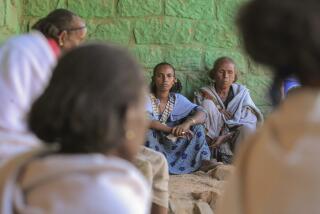Farmer Bets on Age-Old Irrigation System
KHALA, Afghanistan — For Abdul Majid, desperation has become a way of life.
With a fourth straight crop failure looming and a wife and five small children to feed, he has quite literally bet the farm on a last hope: reviving the karez, an age-old irrigation system that just might get enough water to his dying vineyard and almond orchard.
“If this fails, I’m finished,” he said. A hint of defeat was already in Majid’s voice, and his tired eyes carried the bitter sense of tragedy that occurs when good, hard-working people near the end of their strength. He’s already borrowed over $1,100--more than his crop fetched last year.
Now he has breathed deeply again, borrowing one more time against his next crop to fix the damaged karez, or water tunnel system that taps into a spring under a large hill about three miles away. With only a few hundred yards’ extension, the tunnel could bring water to his land and assure a decent crop next fall.
His 8,000 grapevines, 700 almond trees and small wheat field make up only one of many water-starved farms in a small, arid valley here in the heart of Zabol province, about 220 miles southwest of the capital, Kabul. The province is among the worst-hit areas in a nation that is suffering its most severe drought in living memory.
The outcome of Majid’s gamble--and similar efforts by thousands of other destitute farmers--will say much about the ability of Afghanistan’s rural population to survive in areas where this clever and ancient irrigation method exists.
The karez system, often appearing from the air as a string of mole hills, is especially valuable in the withering heat of an Afghan summer because of its unique efficiency. Being underground, it loses hardly any water to evaporation. Designed before the time of Christ, it is constructed at a gradually descending slope so no pumps or electricity are needed.
Though maintenance can be expensive and arduous--most tunnels are 15 to 30 feet below the surface, and some are even deeper--the overall benefit of the karez has been undisputed for centuries.
Although the karezes account for only about 10% of the country’s irrigation systems, here in water-starved Zabol they are plentiful--a decisive factor in efforts to revive the fortunes of men such as Majid.
“They are an important part of the irrigation structure in southern and eastern parts of the country,” noted Stephanie Bunker, spokeswoman for the Office of the United Nations Coordinator for Afghanistan. “They are traditional and they work.”
Getting these old systems going again is viewed by development experts as an urgent priority. A growing number of rural dwellers are coming to the end of their resources.
In Zabol’s eastern district of Shamulzai, for example, many residents have already given up and moved. Those who remain struggle to stay alive.
“There are people reduced to eating alfalfa roots,” said U.N. Development Program officer Sitikula, who, like many Afghans, goes by one name.
Unlike more prosperous provinces such as Kabul and Kandahar, Zabol has no significant commercial activity other than agriculture. And with all but a few thousand of Zabol’s 1 million inhabitants living off the land, the rhythm of life in the province has been devastated.
Here, repeated seasons of no rain have brought more grief than decades of war and years of Taliban rule. And though war and the Taliban are largely gone, Zabol remains a dust bowl.
More than two months into this year’s rainy season, the 200-mile-long Tarnak River, which furnishes much of the region’s irrigation water, is at a fraction of its normal level. Survival requires drastic, often heartbreaking choices.
Mohammed Malansafai, a project officer for the Afghan Development Assn., said that last year many farmers were forced to sacrifice what little their orchards and vineyards yielded by harvesting prematurely. Allowing the fruit to ripen would have sucked the trees dry, he said.
Even that step didn’t prevent disaster. “We estimate about one-third of all trees have been destroyed,” said Malansafai, whose European Union-backed group is working with Zabol farmers.
In part because the province’s climate is harsh and water is scarce even in the best of years, Zabol has a large number of karezes. But most are in disrepair.
Many were destroyed by Soviet forces in the 1980s in an attempt to depopulate the villages and thus deprive moujahedeen warriors of support and supplies. The tunnels also were used by Afghan civilians as shelter during bombings and by fighters to move men and materiel.
Other tunnels gradually filled with silt as farmers, exhausted by years of war and poverty, abandoned their land. Now drought threatens to finish the job.
Majid is just one of many Khala residents at risk of going under. He has been forced to cut down almond trees he bought and nurtured only a few years ago, selling them as firewood at one-twentieth the original cost. The 30-year-old farmer says he uses the money to buy food.
Last winter he sold 100 trees that way. This year, he’s already cut down 300. To avoid defeat, Majid said, he has been working for months to repair a karez on his land that hasn’t delivered enough water since the Soviets bombed it in the 1980s.
To guarantee his next crop, Majid said, he’s ready to mortgage still more of his future so he can hire help to complete the repairs by spring. But a crew specializing in such work recently told him the job would cost more than the $1,600 he said he could afford to pay. Majid is looking for a cheaper offer.
The cost reflects the difficulty and danger involved in repairing a karez. Workers climb down entry shafts to reach the tunnel, then clean out and stabilize weaker sections with ceramic hoops. The work is done by lantern light, usually in extremely cramped conditions--most tunnels are barely large enough for an adult to crawl through.
Gov. Hamidullah Tokhi of Zabol estimates that only one of every 100 karezes in the province is functioning.
“We would like to repair them, but I can’t even pay the police and civil servants,” he said. “How can we afford that?”
As drinking water continues to disappear in the worst-hit areas, villages have emptied. Residents seek shelter with relatives in other areas or flee to Pakistan.
Much like the trees and vines in the fields nearby, part of Khala itself has begun to die. Majid said seven of the roughly 50 families in the village have left, their homes empty shells, as if the village too is suffering from blight.
Tokhi recalled that less than two months ago locals threw flowers on his car when he returned to the province from exile. There was an expectation that he could bring help to ease the impact of the drought. So far, he says, he has managed little.
“People are demanding a lot of things, but we have nothing to give,” he said during a recent interview at his offices in Qalat, the provincial capital. “We have no income, no finance, no economy.”
He paused briefly before adding, “We have nothing.”
*
Marshall was recently on assignment in Khala.
More to Read
Sign up for Essential California
The most important California stories and recommendations in your inbox every morning.
You may occasionally receive promotional content from the Los Angeles Times.










